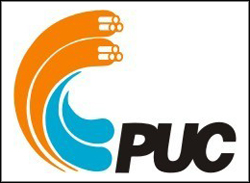 NEWS RELEASE
NEWS RELEASE
PUC SERVICES INC.
July saw the Project reach another important milestone; the engineering design portion of Stage 1’s advanced treatment methods has been completed.
The PUC will now move forward with a call for tenders in early August to construct the advanced treatment methods outlined in Stage 1 of the Water Quality Improvement Project.
Once completed (by this year-end), PUC customers should experience a significant improvement in the colour, taste and odour of their water.
In early 2014, as a key component of the Project, the PUC hired Ipsos Reid to conduct a customer satisfaction survey.
The survey was required so as to establish a clear reference point in order to measure improvement in customer satisfaction after the advanced treatment methods are fully operational.
The survey was completed in May and the results will be presented at the August 11th City Council meeting.
In keeping with the PUC’s commitment to improve communications with its customers, the survey results along with the presentation to Council will be posted on the PUC website and released to the media in conjunction with their presentation at the Council meeting.
After Stage 1 of the Project is fully implemented and the new treatment processes are well stabilized, Ipsos Reid will carry out another customer satisfaction survey, probably in late 2015.
The results of the second survey compared to those of the first survey will provide important information to help determine whether the improvements from Stage 1 are enough to satisfy the concerns of PUC customers regarding the colour, taste and odour of their water.
The survey results, in conjunction with other indicators, will help determine whether or not it is necessary to implement Stage 2 of the Project.
The first stage of the Project also saw the Lorna Wells removed from active service in late May 2014.
With these wells now on standby and ultimately to be abandoned, the PUC commenced a study to identify potential sites for additional wells to replace the lost water capacity.
This study is well underway and more information will be made available in future updates.
In addition to replacing this lost capacity, more production capacity is also required to meet estimated future demands.
As the first step toward obtaining Provincial approval to develop additional capacity, the PUC has initiated the Municipal Class Environmental Assessment (Class EA) planning process.
Public notification and consultation is a key requirement of the provincially mandated Class EA procedure.
These activities will be occurring in the near future.
Customers looking for more information on the Project are encouraged to visit the PUC website; www.ssmpuc.com or call Customer Service at 705-759-6522 Monday through Friday (9 a.m.-4:30 p.m.).
The PUC is committed to keeping its customers informed on the progress of this important Project with these regular monthly updates.
What are the “Advanced Treatment Methods”?
The advanced treatment methods being implemented involve incorporating soda ash (sodium carbonate) and carbon dioxide into the treatment process to adjust and harmonize pH levels across the entire system.
Soda ash is very similar to everyday baking soda and is a common food additive, used in many foods such as chocolate milk, baked goods, beer and wine.
Carbon dioxide (CO2) is used in carbonated beverages.
Additionally a corrosion inhibitor, blended phosphates, will be added in order to reduce the amount of lead in the water at the customer’s tap.
Phosphates are another class of food additives that are also added to many familiar foods, including cereals, coffee and tea, flour, coconut milk and many more.
Soda ash, phosphates and carbon dioxide are commonly added to drinking water by water utilities throughout North America and Europe.
While they impart no direct taste, odour or colour to drinking water, adding them at very low concentrations can help improve all of these things – and help reduce lead at the tap.
*************************